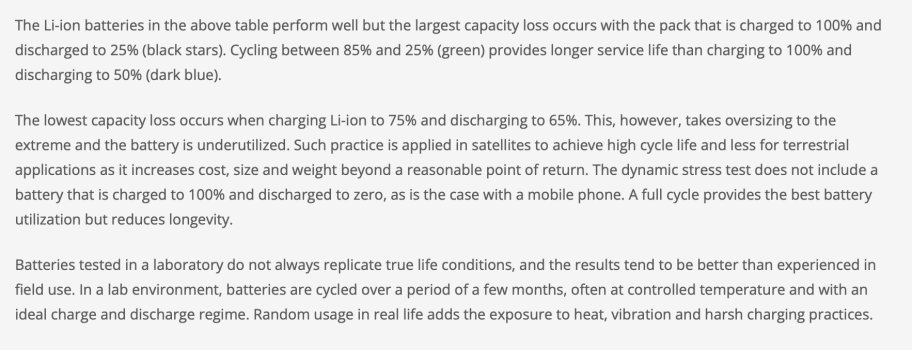From Isidor Buchmann's book - Batteries In A Portable World - the guy who made Battery University:

Got a tip for us?
Let us know
Become a MacRumors Supporter for $50/year with no ads, ability to filter front page stories, and private forums.
iPhone 13 How much battery do you have left on your iPhone 13 before you charge it?
- Thread starter MagOnetech
- Start date
-
- Tags
- charging iphone iphonebattery
- Sort by reaction score
You are using an out of date browser. It may not display this or other websites correctly.
You should upgrade or use an alternative browser.
You should upgrade or use an alternative browser.
Battery University is using the terminology of a charge cycle being a complete 0-100% usage of your battery - this is industry standard. So charge cycle to Battery University is not just a charge but a full 0-100% usage of the battery's capacity.
So 100 10% charges = 1 cycle.
2 50% charges = 1 cycle.
“Battery charging and discharging once is called a battery cycle”
As long this is not clear what battery university understands under “one cycle” I stay with one cycle = one charge.

What is a battery cycle? - The Best lithium ion battery suppliers | lithium ion battery Manufacturers - TYCORUN ENERGY
In the process of use, the actual available capacity of lithium ion battery, relative to its rated capacity at the factory, will continue to decrease, that
Yes, discharging from 100% to 0% and charging back up is considered 1 cycle by the industry, Apple, and Battery University.“Battery charging and discharging once is called a battery cycle”
As long this is not clear what battery university understands under “one cycle” I stay with one cycle = one charge.

What is a battery cycle? - The Best lithium ion battery suppliers | lithium ion battery Manufacturers - TYCORUN ENERGY
In the process of use, the actual available capacity of lithium ion battery, relative to its rated capacity at the factory, will continue to decrease, thatwww.takomabattery.com
You are more than welcome to think what you want.
I took the time and checked the reference of battery university. Found this:Yes, discharging from 100% to 0% and charging back up is considered 1 cycle by the industry, Apple, and Battery University.
You are more than welcome to think what you want.
”For each test, the cell first starts at a set SoC level and the DST profile is applied repetitively until the set stop level is reached. The cell is then recharged back to the starting level at a 1 C-rate to finish one test cycle.”
So still: one charge one cycle for me 😁
But yes apple counts differently.
That's totally cool. I think I see what you're saying. The specific differentiation between DST / Test cycles vs Charge Cycle terminology.I took the time and checked the reference of battery university. Found this:
”For each test, the cell first starts at a set SoC level and the DST profile is applied repetitively until the set stop level is reached. The cell is then recharged back to the starting level at a 1 C-rate to finish one test cycle.”
So still: one charge one cycle for me 😁
But yes apple counts differently.
Basically what we're saying in this thread is: Not fully charging = prolongs the life of the battery. From a charge cycle (Apple definition) viewpoint, this shouldn't increase charge cycles.
BUT yes (what I think you're saying), it will definitely increase duty cycles and the amount of times you charge which for most people is an unacceptable cost.
Check out: https://batteryuniversity.com/artic...atteries-do-not-last-as-long-as-an-ev-battery
Specifically this part (might help a little (not for cycle terminology but overall idea of saving a battery)):
Attachments
Bookmarking this forever for future use.Apple defines it exactly the way I described it:

Batteries - Why Lithium-ion?
Learn why Apple rechargeable lithium-based technology provides the best performance for your iPhone, iPad, iPod, and MacBook.www.apple.com
Check that page out (link above from Apple itself):
View attachment 2120032
"Charge your Apple lithium-ion battery whenever you want. There’s no need to let it discharge 100% before recharging. Apple lithium-ion batteries work in charge cycles. You complete one charge cycle when you’ve used (discharged) an amount that equals 100% of your battery’s capacity — but not necessarily all from one charge. For instance, you might use 75% of your battery’s capacity one day, then recharge it fully overnight. If you use 25% the next day, you will have discharged a total of 100%, and the two days will add up to one charge cycle. It could take several days to complete a cycle. The capacity of any type of battery will diminish after a certain amount of recharging. With lithium-ion batteries, the capacity diminishes slightly with each complete charge cycle. Apple lithium-ion batteries are designed to hold at least 80% of their original capacity for a high number of charge cycles, which varies depending on the product."
From the Apple Article............
"The amount of time it takes to reach that first 80% will vary depending on your settings and which device you’re charging."
Is this an unwritten reference to "optimum charging", which probably is only beneficial to those who sleep in the same place every night, and get up at the same time seven days a week?
"The amount of time it takes to reach that first 80% will vary depending on your settings and which device you’re charging."
Is this an unwritten reference to "optimum charging", which probably is only beneficial to those who sleep in the same place every night, and get up at the same time seven days a week?
Last edited:
Register on MacRumors! This sidebar will go away, and you'll see fewer ads.


